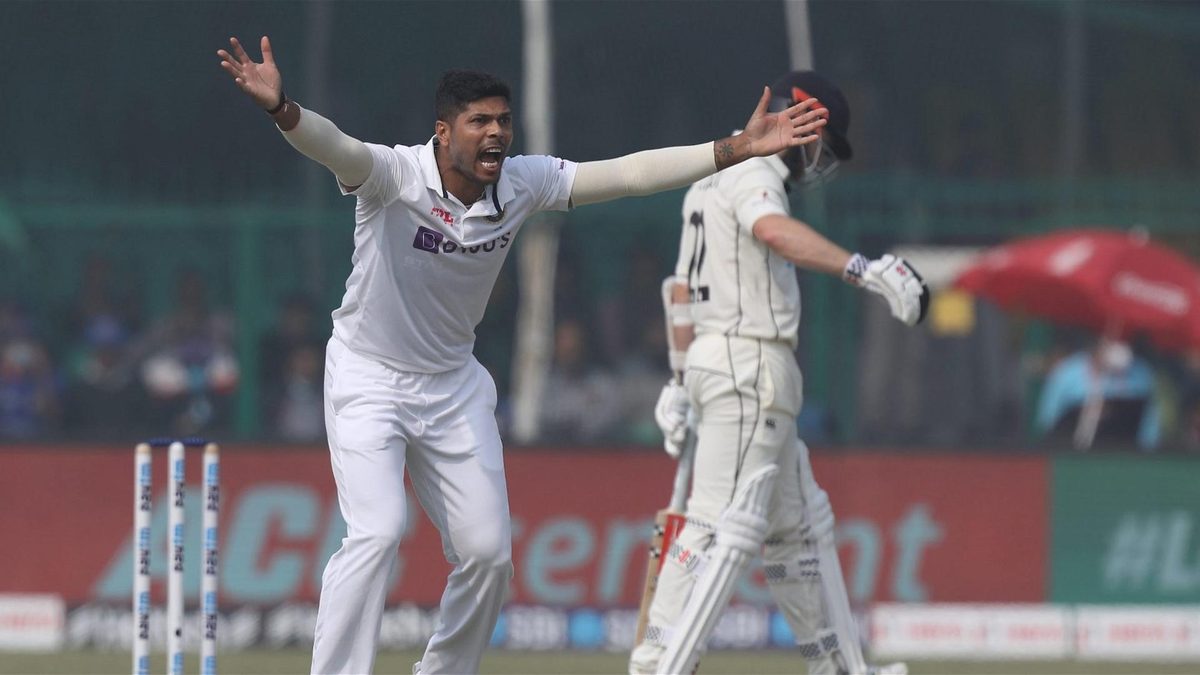
The first Test between India and New Zealand was meandering along when Umesh Yadav was called upon to bowl.
Prior to that, the India bowlers had toiled. They only had a solitary wicket to show for their efforts, with Will Young and Tom Latham obdurate opening the batting. The hosts were looking towards Umesh to provide some sort of inspiration, but the first over the pacer bowled was a laborious one. His speeds weren’t tickling the 140kph mark and the batters remained comfortable. A few balls later, India opted for the new ball and handed it to Axar Patel. But a million eyeballs remained trained on Umesh, waiting for Axar to finish his over. Not because it was the final over before lunch, but because Umesh has a proclivity of breaking crucial partnerships with moments of unexpected but utter brilliance.
The surface in play for the Kanpur Test is a sluggish one, a pitch where run-scoring isn’t easy but picking wickets is equally cumbersome. Even when bowlers have deceived batters in the air, the latter have been able to adjust owing to the slowness of the track.
Thus, if anyone were to suggest that a pacer would hustle Kane Williamson, trap him on the crease and make New Zealand stare into the abyss, they would’ve been scoffed at. To an extent, such a form of dismissal was even bordering on absurdity.
Umesh, though, had other plans. He dismissed the Kiwi skipper in that very manner and showed what he is all about, especially in home conditions. He extracted life from a drab and docile surface. In other words, he did what no one thought was possible.
The Black Caps never really recovered and once Axar Patel began weaving his magic, there was no way back. Axar has garnered the majority of the plaudits, and rightly so. Yet, one can’t deny the importance of Williamson’s wicket on the stroke of lunch. That Umesh defied cricketing logic, wisdom and a few laws of physics, only made it sweeter.
Over the years, Umesh has developed quite a reputation when playing Tests in India. Numbers drive that point home too. Throughout his career, Umesh averages 24.8 having scalped 97 wickets at home. Of those, 82 (excluding the Williamson wicket) have come in victory, indicating that he is a genuine match-winner.
His strike rate, however, is his biggest strength. Often looked upon as a pacer with a tendency to leak runs, he also has the ability to keep picking wickets regularly, and to break through when nothing is happening. Overall, his strike rate at home hovers around the 46.3 mark. To attach further context, his strike rate in home conditions is better than several fast-bowling greats, including Chaminda Vaas (60.7), Ishant Sharma (65.2), Wasim Akram (51.1) and Zaheer Khan (70.2).
In recent times, Umesh has gone to another level, stealing a march over everyone else. In home Tests since the start of 2019, has accounted for 24 batters (in nine innings) and averages 15.16. His strike rate, which proudly sits at 26.6, isn’t too shabby either. Ishant has also been successful at home during this period. But he has played four matches more than Umesh to muster 20 scalps. His average (22.45) and strike rate (48) are also considerable downgrades, though still impressive.
Mohammed Shami is the only fast bowler (minimum of 15 wickets) to have a better average (14.9) than Umesh at home in that time. However, he has accumulated that tally across 10 innings. His strike rate, meanwhile, is worse (33.3 as compared to Umesh’s 26.6).
Even when talking about overall performances since 2019, there isn’t a fast bowler who can hold a candle to Umesh. He has picked up 34 wickets in nine games at an astonishing average of 19.86 and gets a wicket every 35.6 balls. In the same period, Jasprit Bumrah has picked up 53 wickets in 15 matches. Ishant and Shami, meanwhile, have notched up 78 (15 matches) and 53 wickets (15 matches), respectively. None, however, has an average or a strike rate better than that of Umesh.
Sheer stats aside, Umesh’s biggest asset is his ability to skid the ball through, even on lifeless pitches. With most surfaces in India not offering a lot of bounce, he always seems to be in the game. The fact that 48 of his 97 wickets at home have either been bowled or LBW lends further weight to that argument.
Most tellingly, though, Umesh seems to have developed some sort of control – control that went amiss at the start of his career and has perhaps played a major role in how he is perceived as a pacer. Till a few years ago, he was a fast bowler capable of brilliance but also prone to falling off a cliff completely. He still remains a seamer adroit enough to conjure moments of magic but has seemingly eradicated the unpredictability around his bowling.
Hence, a case could be made for Umesh to be mentioned in the same breath as Bumrah, Ishant and Shami, especially when talking about India’s best pacer. When solely talking about Tests in India, that accolade should be reserved for Umesh. Not just because the numbers say so, but also because he seems better-equipped on so many different fronts.
The last time India played a Test (before Kanpur), Umesh broke open the game by producing the ball of the series (arguably) against Joe Root at The Oval. Maybe then, the Williamson dismissal wasn’t bordering on absurdity after all. Instead, it is a routine that Umesh has made the Indian fans accustomed to lately.








